
ICCROM_ICS11_History_en
.pdf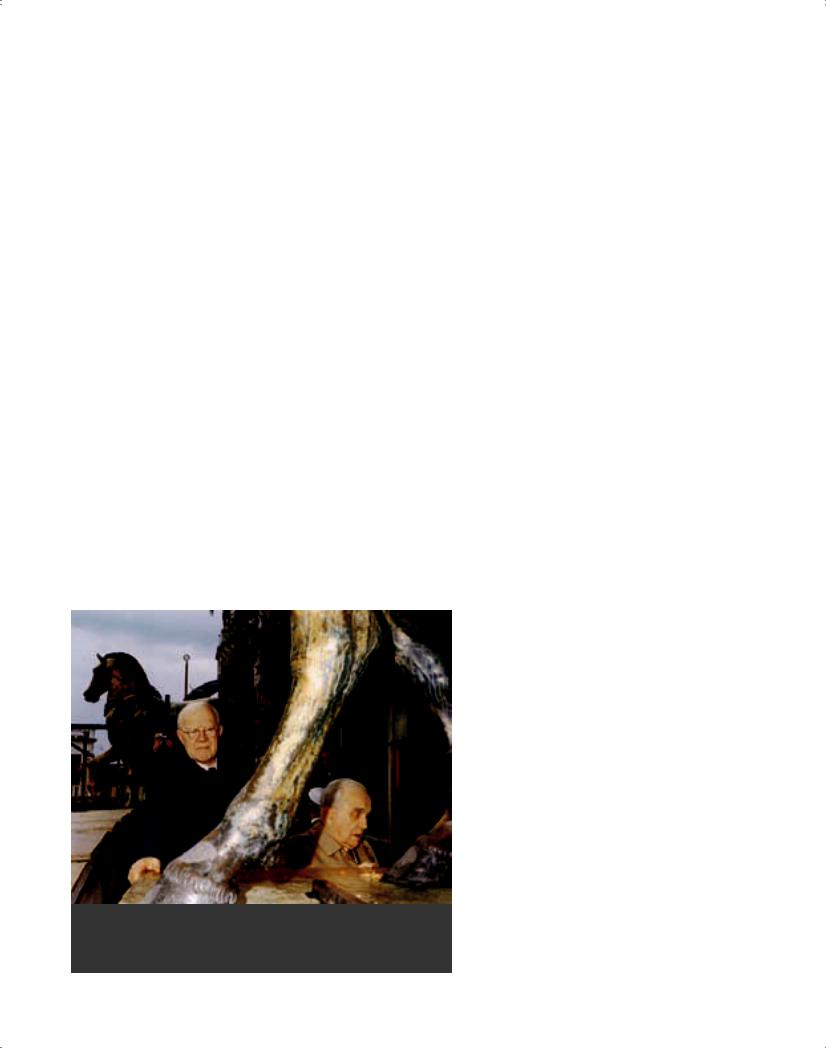
can meet and work |
on an interdisciplinary level. |
It now has some 22 |
Working Groups which bring |
together expertise on such subjects as the scientific investigation of objects of significance to cultural and natural history; optimizing solutions to conservation problems; developing standard techniques and manuals; planning disaster management and preventive conservation.129
Conservation theory
The international conference on historic preservation organized in Williamsburg (10-16 September 1972) became an important landmark for American thinking in restoration.130 Plenderleith started his keynote paper131 by observing: “The experimental nature of the present meeting is perhaps its most outstanding feature, for this is the first time that architectural preservationists have been confronted (in the best sense of the term) by museum conservators. The two groups have many interests in common: Both are concerned with materials, their characteristics and permanence, and both are interested in the environment.” Regarding these two groups of specialists, conservators and preservationists (to use the American terms), Plenderleith recalled his arrival at the Rome Centre, noting: “At the Rome Centre (as it came to be called), I found that there were not two separate worlds of conservation and preservation, however convenient this might be for purposes of classification. There is only one world. Conservators and preservationists are all under one umbrella, so to
Figure 4 7
H.J. Plenderleith examining the state of conservation of the bronze horses at St. Mark’s in Venice
speak.” He hoped that a formal confrontation with the two groups of specialists could prove profitable. “We conservators know that we have a great deal to learn from preservationists, much of which will be of value in helping us to work together. We hope that we will be able to offer preservationists something in return that will be equally stimulating.”
The 1972 Williamsburg conference was not only an American conference but an international landmark meeting of specialists representing the different fields, grouped under the following subheadings: a) occupations and organizations, b) materials and techniques, c) standards and education. The participants included the foremost experts in the USA and in the network of the International Centre for Conservation, many of whom were already or soon became close collaborators with the Centre, such as Robert M. Organ, Albert France-Lanord and Donald W. Insall, or who were active in training institutions, such as James Marston Fitch, and in other international organizations such as ICOMOS (Raymond Lemaire and Ernest Allen Connally). Two papers were given regarding philosophy and criteria of historic preservation, one by George McCue, the other by Paul Philippot. McCue132 gave case studies in the USA, speaking about preservation as a ‘people process’, e.g. noting the ‘WilliamsburgDisneyland Syndrome’ in ‘historic districts’. In his comments on McCue’s paper, Insall says that he found himself “magnetized by his unspecified, but quite clear question: What does one do when experts disagree?”134 Regarding Philippot’s paper,133 William J. Murtagh noted that the question that emerged was: “What qualities and values must be considered when one is evaluating the linkages of buildings in an area (or what is in the United States called a historic district)?”135 Philippot’s Williamsburg paper was a synthesis of lectures he gave at the Rome Centre, presented in a systematic manner. It is a fundamental paper that touches on all the issues related to recent advances in ‘restoration culture’. His basic reference remained Cesare Brandi whose writings on the theory of restoration had been collected into a publication in 1963,136 but Philippot was able to analyse this not-so-readily accessible thought and present it with concrete examples to the different disciplines, including art historians, architects and archaeologists. In a nutshell, the essential basis of Philippot’s thought was:
“One should think that the issue that unifies the participants in a training programme as well as in a restoration is the object itself. Taking each problem in reference to the object, as a whole, one has always all the dimensions of restoration.
50 |
ICCROM and the Conservation of Cultural Heritage. A history of the Organization’s first 50 years, 1959-2009 |
|
|
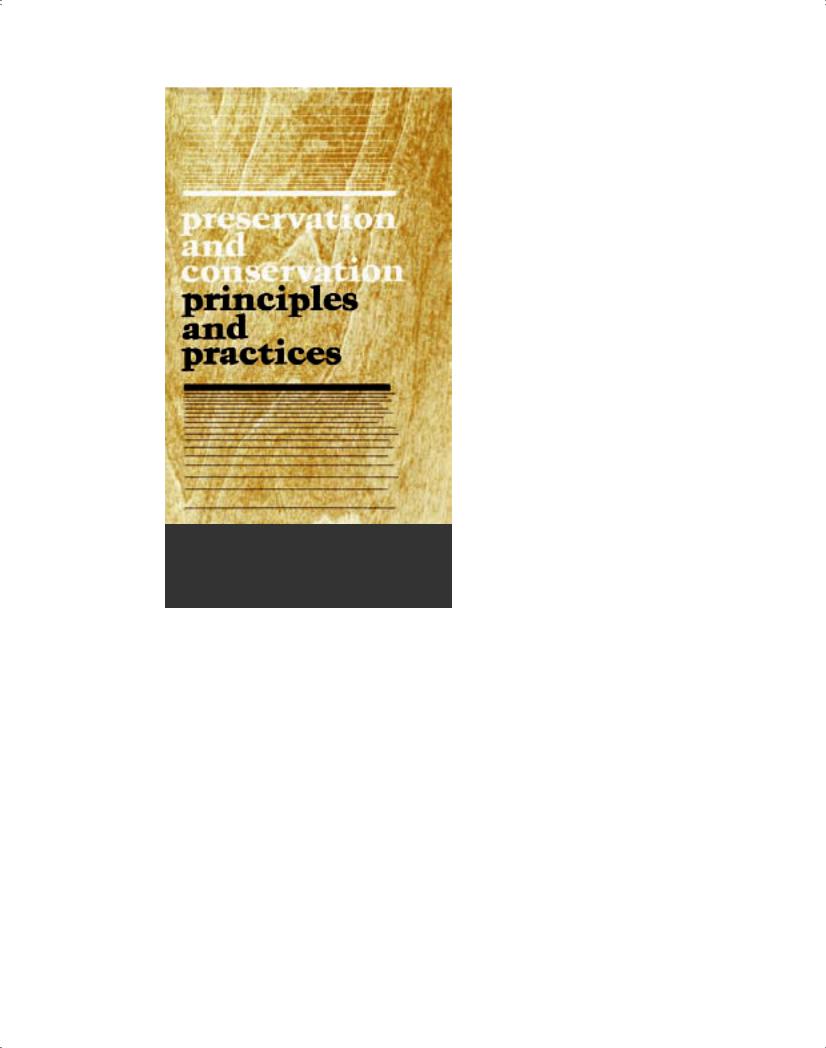
Figure 4 8
The publication of the acts of the joint international conference organized by ICCROM and the National Park Service of the United States, Williamsburg, 1972
Everything will thus necessarily be seen in this context. First one should start by defining the object, and then continue defining the necessary care for the object. One thus returns to Brandi’s theory: the recognition of the work of art in its physical consistency and in its twofold historical and aesthetic polarity, in view of its conservation for the future. This should be the philosophy of the course, and it should always be the nucleus of all work. Considering the theory of restoration only as an introduction is a purely geometrical way of thinking, taking that there are theorems and that these are followed by the consequences.
But, it does not work like that; everything should always be referred to the object. The object was there at the beginning, and the object is there at the end. Following from what you know or learn, you pose certain queries, and the object responds. And so it continues. If one does not take good care of the object, he is not
a restorer, even though he may be an excellent scientist or a clever art historian. According to the concept of Brandi, you should introduce restoration at the moment of the perception of the work of art. Every time when you recognize a work of art, you already do restoration. You re-establish the work in its reality, even if you do not interfere. This operation can be quite difficult depending on what has occurred to the work as an object. It is therefore necessary to clarify the situation. When a work has been repainted, one should decide if the additional layers should be removed or not, i.e., what is their significance. Therefore, one is already in the restoration.”137
While Plenderleith, and with him Giorgio Torraca, had created the scientific foundations of the Rome Centre, Philippot was responsible for the policies and especially for the philosophy and theory that underlay the policies. Under the umbrella of the Centre, these two approaches were integrated. From the start, as has been noted already, it was Philippot who wrote the policy reports to the Council and the General Assembly, and it was he who provided the Centre’s principal contribution to theory in training programmes. However, this was done in full understanding of the scientists and other disciplines. His teaching was complemented by that of Italian colleagues, above all De Angelis d’Ossat, Carlo Ceschi and Piero Gazzola.
The 1970s became a key period in the development of conservation policies and expansion of the notion of ‘heritage’ from monuments to historic urban areas and even the ecological context. The Centre attended the events of the European Architectural Heritage Year in 1975, and it was involved (through the Italian architect Luciano Pontuale) in the preparation of the Recommendation Concerning the Safeguarding and Contemporary Role of Historic Areas, adopted by UNESCO in 1976.
In 1976 the Centre in its role as Advisory Body to the World Heritage Convention was invited by UNESCO to discuss the concept of outstanding universal value (OUV). The informal gathering took place in Morges (France), and the discussion focused particularly on the definition of ‘universal’. This could be interpreted as “meaning that a property submitted for inclusion in the WHL should represent or symbolize a set of ideas or values which are universally recognized as important, or as having influenced the evolution of mankind as a whole at one time or another.” Torraca represented the Centre at the meeting and presented a paper written by Philippot on the concept of OUV, in which he claimed
4 International Centre for Conservation (1971-1977) |
51 |
|
|
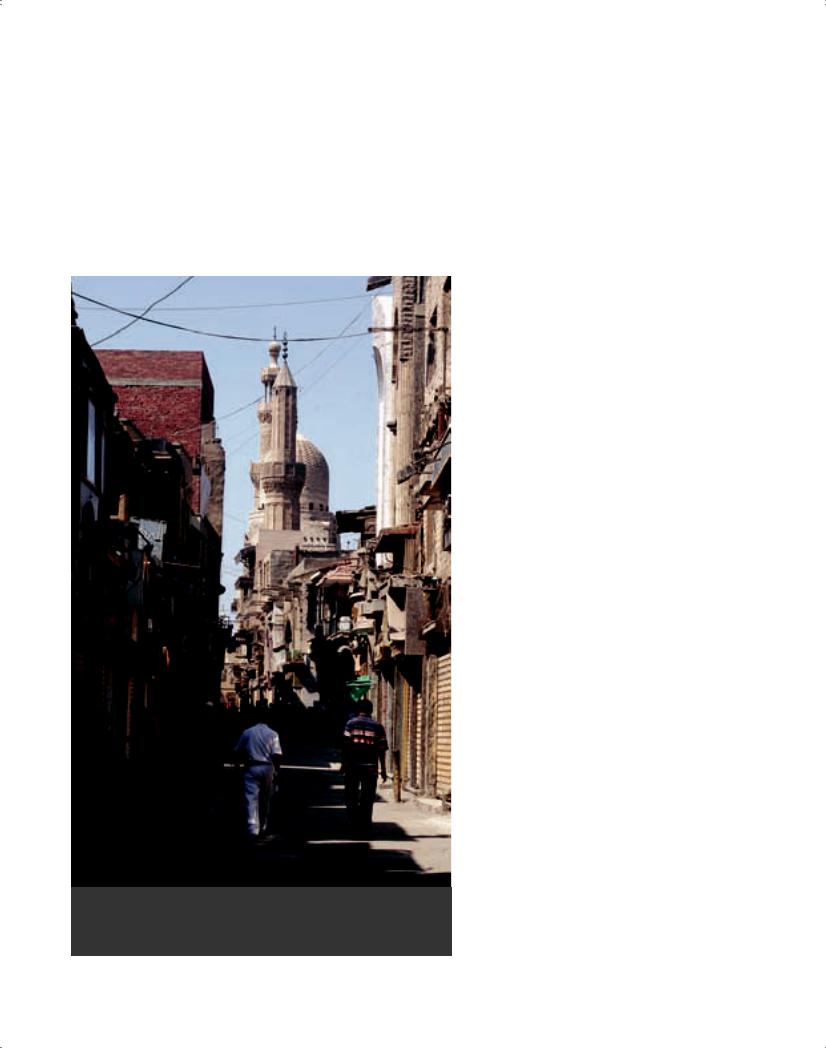
that this “cannot be justified except when referred to specialized scientific literature on the subject, which is considered the most up-to-date expression of the universal consciousness on the issue.”138 The paper stressed that artistic value should be referred to an original or unique creation of exceptional quality, universally recognized by competent specialists in the field concerned. Secondly, the paper highlighted historic value as a testimony of the uniqueness of the document, the influence exercised in time and
Figure 4 9
Old Cairo, one of the first World Heritage Sites to be inscribed on the List, in 1979
space, and its importance to the comprehension of the advance of related historic events. Thirdly, the paper noted the need to recognize a property for the ‘typological value’ in order “to guarantee that the characteristic works of a certain tradition, menaced by disappearance due to development of modern life, could be saved and conserved in the form of typical examples, representative of a culture that risks disappearance, as well as in cases where these types of works do not represent the unique character qualifying works recognized universal from the artistic or historic point of view.”139
The ICCROM training programmes and particularly the International Architectural Conservation Course (ARC) followed closely these developments. The ARC courses not only included lectures by the chief protagonists in different countries, but also hands-on case studies, in places such as Capua, Bologna, Ferrara, Tivoli, and Rome itself. Similarly, the the participants of the Mural Paintings Course applied the methodologies that were developed on concrete cases in Rome and Sermoneta. The Centre established links with other training centres such as the Institute of Advanced Architectural Studies at York (IoAAS), with which it signed a special agreement for the exchange of expertise. The Centre invited British specialists to teach at the Centre, including Derek Linstrum, Bernard M. Feilden, Patrick Faulkner and Roy Gilyard-Beer while Jokilehto, as the co-ordinator of the ARC Programme at the Centre, was regularly invited to lecture at York.
In the same period Paul Schwartzbaum, responsible for the Mural Paintings Conservation Course, established close collaboration with Asian countries, particularly Thailand where the Centre had had a long involvement.140 He also led the project for restoration of the mural paintings in the Al Aqsa Mosque in Jerusalem, for which ICCROM was to receive the Aga Khan Award in 1986. Meanwhile Gaël de Guichen was applying conservation theory to the conservation of movable heritage and museum collections.141 The great merit of the Centre’s training programmes was that they introduced conservation theory to various realities in the world.
Publications
The Centre contributed to a number of low-cost publications in the collection of Technical Notes written by the teaching faculty of its training programmes. In 1971-73, these included topics such as: Humidity in Monuments (G. Massari), Study of Monuments (G. De Angelis d’Ossat), Pathology and Restoration of Stone Constructions (M. Mamillan), Deterioration and Conservation of Porous Building Materials in Monuments
52 |
ICCROM and the Conservation of Cultural Heritage. A history of the Organization’s first 50 years, 1959-2009 |
|
|
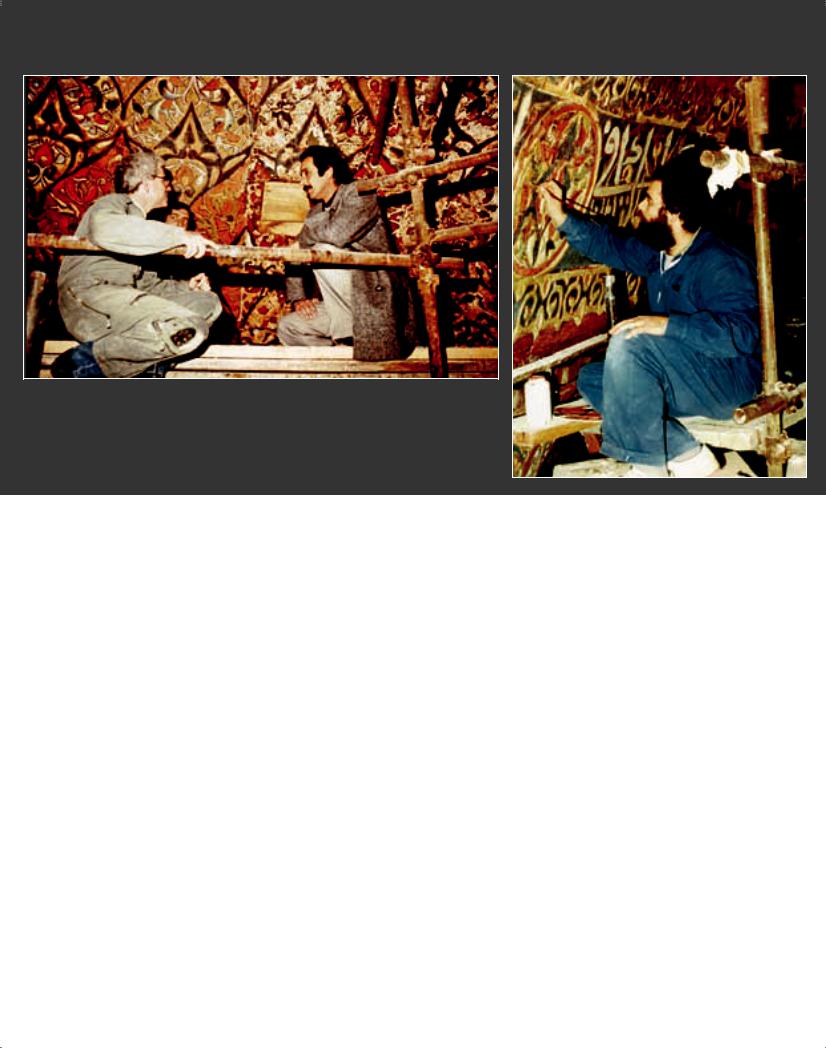
Figure 4 10
Conservation of paintings in the Al Aqsa mosque, Jerusalem, 1984; Paul Schwartzbaum (left) and Isam Awad engineer in charge, Al Aqsa Mosque (right) were responsible for the project
Figure 4 11
Conservation of paintings in the Al Aqsa mosque, Jerusalem
(T. Stambolov and J.R.J. van Asperen de Boer), as well as Emergency and Safety Measures for the Protection of Cultural Property (H. Foramitti), Establishment of a Service for Architectural Photogrammetry (M. Carbonnell), Causes of Alteration of Mural Paintings (P. Mora) and Solubility and Solvents for Conservation Problems (G. Torraca).142 Other authors included Piero Gazzola (on conservation policies), Hans Foramitti and Giorgio Boaga (photogrammetry), François Sorlin (safeguarding the built heritage) and Edgar Schultze (structural consolidation).
Published in collaboration with ICOM was a more extensive publication by G. Massari: Bâtiments Humides et Insalubres (a translation from the Italian published by Eyrolles in Paris, 1971). Eyrolles also published a book by Bruno Mühlethaler and other specialists entitled Conservation of Waterlogged Wood and Wet Leather, and one by D.M. Flyate on Causes of Deterioration of Written and Printed Documents (translated from Russian). Other publications included conference papers, such as the important Proceedings of the Regional Seminar in Williamsburg and Philadelphia (1972) and Proceedings of the Regional Seminar on Conservation in Latin America, Mexico (1973). From 1973 the Centre also started publishing an annual NewsletterChronique in English and French.
Training: regular annual courses in Rome
The training programmes established in the 1960s (on Architectural Conservation and the Conservation of Mural Paintings) continued and were further developed through this period. The Centre added two new courses, one on Fundamental Principles of Conservation and the other on Preventive Conservation in Museums, both of which became part of the regular programme of the Centre. In 1975 and 1976, it also organized an Italian Regional Course on the Fundamental Principles of Conservation, and in the latter year the first international Course on Stone Conservation in Venice.
Scholarships for the Centre’s course participants came from different sources, including UNESCO, the Italian Government, the French Government, the Belgian Government, and the JDR 3rd Fund. Besides the regular courses, the Centre continued assisting groups of students and professionals by organizing programmes of study tours. Similarly, on request, the Centre assisted individuals, particularly UNESCO scholarships holders, to organization their own studies either at the Centre itself or at other institutions or laboratories. The personnel of the Centre continued the tradition of lecturing in various international training courses. These included, for
4 International Centre for Conservation (1971-1977) |
53 |
|
|
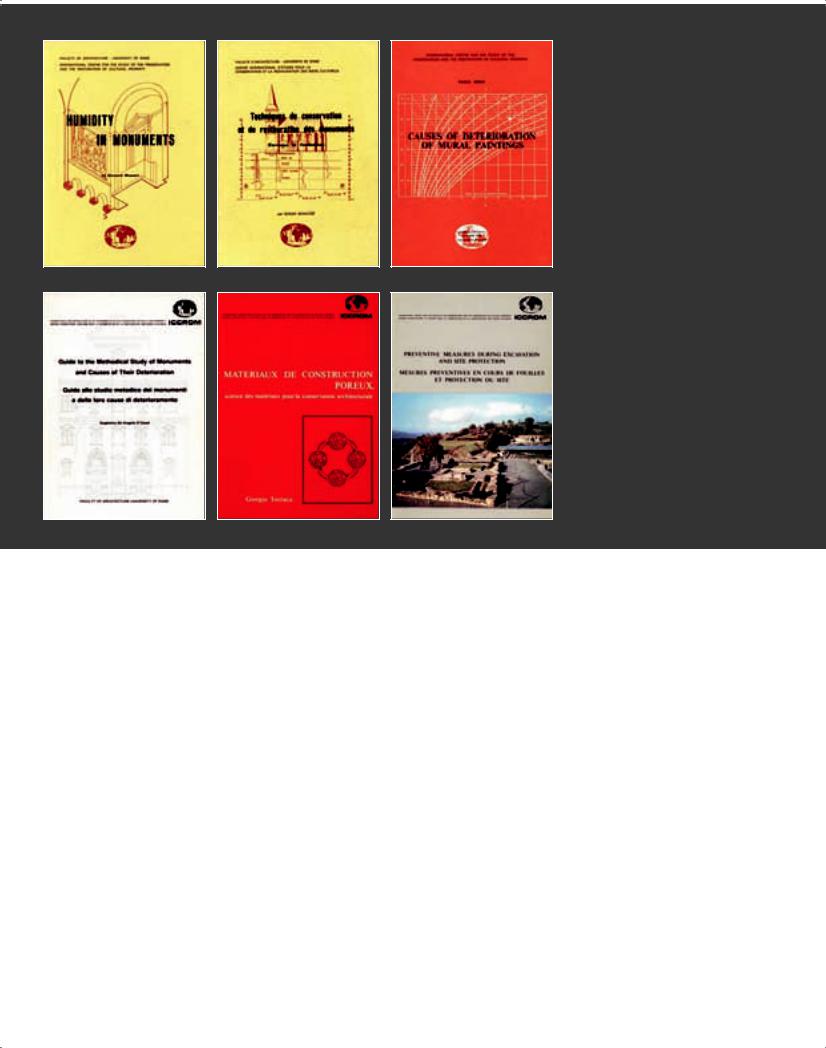
Figure 4 12
Examples of ICCROM’s classic early publications:
a) Massari; b) Schultze; c) Mora; d) De Angelis; e) Torraca;
f) Stanley-Price
a |
b |
c |
d |
e |
f |
example, the University of York and the University of Zagreb in Split (Jokilehto), the Regional Centre for Conservation in the Arab States in Baghdad (de Guichen) and Columbia University in New York (Philippot).
Architectural conservation
The Course of Specialization in the Conservation of Monuments and Historical Sites continued under the direction of De Angelis d’Ossat.143 In 1973 Italo Angle, who had been responsible for the general coordination of the Architectural Course, resigned from the Centre after being promoted to a new position at the Ministry of Education and Science and Jokilehto was employed as the course co-ordinator. The course programme integrated field projects involving practical analysis of historic buildings and areas with study trips in Italy and neighbouring countries. The object of the field study in 1971 was the historic centre of Capua, near Naples, and in 1972 the historic centre of Tivoli, near Rome. In both years groups of students attended additional training in Segovia (Spain) under the guidance of Alberto Garcia Gil, and other groups went for specialized training
in photogrammetry at the Bundesdenkmalamt in Vienna. In 1974 at the end of the course the students were invited to undertake an analysis of the historic town of Trogir in Yugoslavia, guided by Tomislav Marasovic, a former participant and assistant of the ARC course. From 1975 on, the field work was generally carried out on selected buildings or areas in the historic centre of Rome, including the complex of San Michele itself. One issue under discussion was the advantages of computerization for the conservation planning of historic urban areas.
In 1974-1976, the course structure was reviewed with the aim of better structuring the programme (review by Jokilehto in consultation with Bernard Feilden and Luciano Pontuale).144 The increased number of students accepted by the University of Rome started to create problems of course organization and in 1975, in order to ensure that the fieldwork would be beneficial, the course was divided into three groups, English-, Frenchand Italian-speaking.
At its meeting in April 1976, the Council again raised the issue and the Director responded that the problem was serious. Feilden reported on the course structure to the Council: “According to him,
54 |
ICCROM and the Conservation of Cultural Heritage. A history of the Organization’s first 50 years, 1959-2009 |
|
|

the Course is very well balanced. Conservation of monuments is an interdisciplinary activity where chemists, architects and art historians meet. It must be understood that practical solutions vary considerably from one country to another.”145 The Council discussed the issue of the number of students with De Angelis d’Ossat, who suggested two options: one was to hold the course twice a year (first from September to February, and then
from February to June/July); the second option was to have an evening course for the Italian students, while the international students would attend the course during the day.146 Finally, it was agreed to form a small committee to study the question. As a result, in agreement with the Faculty of Architecture of the University of Rome, it was decided to separate the Course into two parts, with both courses remaining under the general direction of
Figure 4 13
The small town of Trogir on the Dalmatian coast in the former Yugoslavia
Figure 4 14
ARC 1975 course exercises: preparing measured drawings of the Anglican church of Saint Paul’s within the Walls, Rome: Christine Lamoureux (Belgium), Mehr-Azar Soheil (Iran), and Cristina Dahlgren (Sweden)
Figure 4 15
ARC 1977 course exercise: recording the interior of the ancient church of S. Stefano Rotondo, Rome
Figure 4 16
Training in photogrammetry; Maurice Carbonnell (France) and Hans Foramitti (Austria) with ARC 1971 participants
4 International Centre for Conservation (1971-1977) |
55 |
|
|
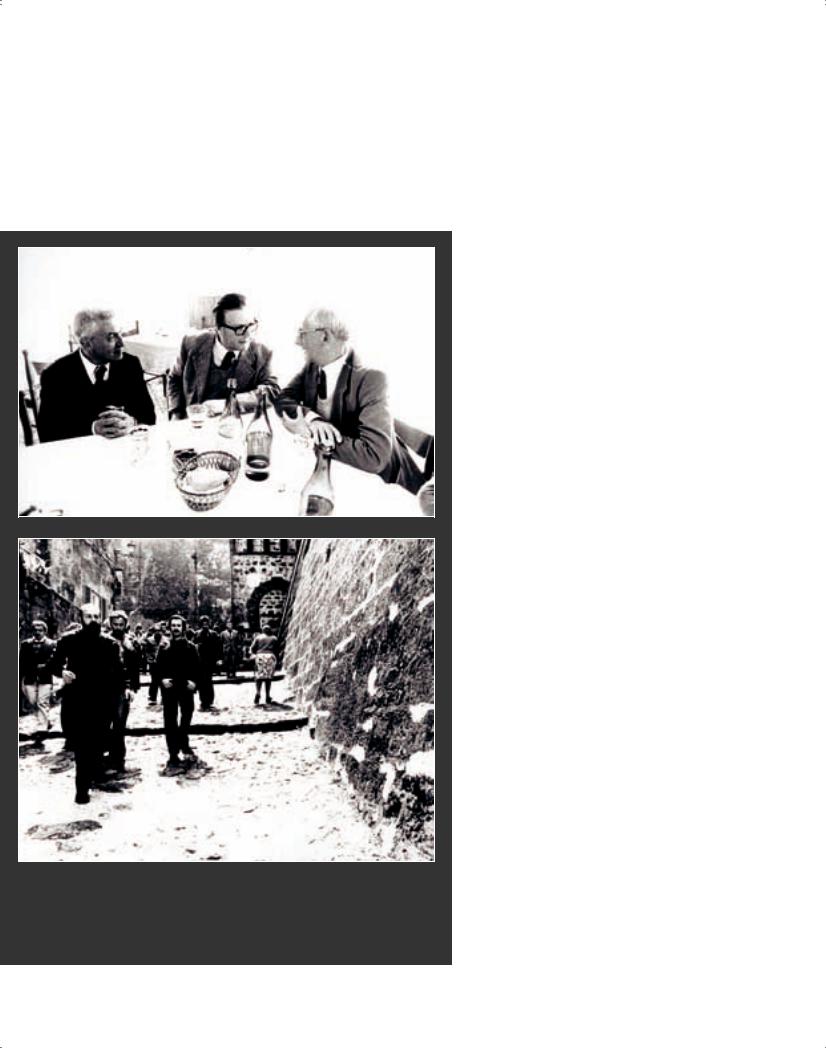
De Angelis d’Ossat and the co-ordination of Jokilehto. The Centre continued hosting Course A organized by the University with Gaetano Miarelli-Mariani as consultant assisted by Giovanni Carbonara and Stefano Marani.147 Course B was organized by the Centre and was henceforth called the Architectural Conservation Course.
Figure 4 17
ARC 1975 course teachers: Giuseppe Zander, Paolo Mora and Edgar Schultze
Figure 4 18
ARC 1975 course: architect Eugenio Galdieri guiding a study tour to Palazzo Farnese, Caprarola, Italy
Mural paintings
The Course on the Conservation of Mural Paintings continued in collaboration with the Istituto Centrale del Restauro, under the scientific direction of Paolo Mora and Laura Sbordoni-Mora, assisted by Antonella Merzagora. It was held in French in 1975 and in English in 1976. The lack of a course co-ordinator was rectified with the appointment of Paul Schwartzbaum (USA), painting restorer and biological scientist, from 1975. The course carried out practical work in selected palaces or churches in Rome and in the castle of Sermoneta near Latina, the property of the Caetani family. The castle itself was an attraction and became a vivid memory to all who attended the course. The participants of the Architectural Conservation Course were also introduced to Sermoneta, as were delegates to some of the General Assemblies.
In 1975 the course fieldwork was on the frescoes of Salvati and Zuccari in the Salon des Fastes Farnésiens in Palazzo Farnese in Rome. The employment of Schwartzbaum and the publication of the book by Philippot and the Moras on the conservation of mural paintings allowed the structure of the course programme to be revised so as to allocate more time to seminars, and also to test the fundamental principles of mural painting conservation in their published form. A consultancy with Anika Skovran (conservator at the National Museum of Belgrade, Yugoslavia) led to further development of the technical documentation and to a new liaison between the Mural Paintings course and the Architectural Conservation Course.
Fundamental principles of conservation
When the Centre was created, it was understood that it was not to be another conservation research laboratory that competed with other major laboratories in the world. Rather, its task was to establish collaboration between these different centres in order to facilitate understanding between the disciplines and improve the quality of the conservation work, whether in the laboratory or in the field. With time, it became clear that there was a need for training in conservation science, which would require laboratory space and equipment.
Giorgio Torraca proposed that it was legitimate to have a didactic scientific laboratory. His idea was that if conservators, architects, historians and scientists active in conservation knew about the structure of materials and the problems of durability, they were less likely to cause damage to cultural property. While studying together, the various professions could develop a common language and interact more efficiently in their interdisciplinary
56 |
ICCROM and the Conservation of Cultural Heritage. A history of the Organization’s first 50 years, 1959-2009 |
|
|
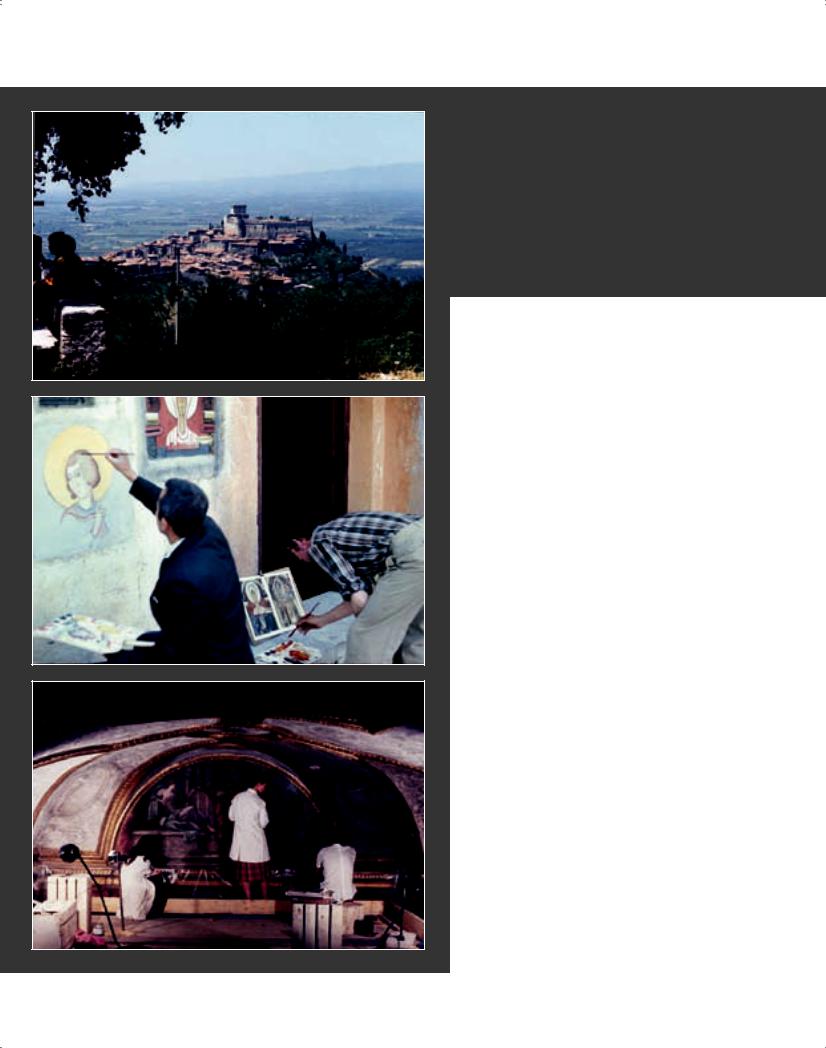
Figure 4-19
The town of Sermoneta with its Renaissance castle in the Province of Latina, south of Rome
Figure 4-20
Participants of the 1972 Mural Paintings Course in San
Michele, Rome
Figure 4 21
The ICCROM Mural Paintings Course collaborated with the ICR to restore the wall paintings of the Palazzo Farnese in Rome
work. Indeed, it was said that in his lectures Torraca was able to make complicated science so clear that even an architect could understand it.
Initially, due to the lack of funds, any laboratory research had to be carried out with a substantial support from other, specialized laboratories. This had been the case with the research on mudbrick and on stone carried out earlier in the decade. But to what extent could ICCROM act on its own? Torraca recalled:
“But could ICCROM start and run a technological research programme of its own? With the approval of another proactive director (Feilden), we decided that we could, and by claiming that a research project in conservation techniques is a training opportunity (which undoubtedly it is) we were able to raise a work force by means of some modest training scholarships offered by the European Community. So, relying on the technical support of the Istituto Centrale del Restauro and the Faculty of Engineering of Rome University (that provided equipment for mechanical testing) we created two Research Training Units composed of conservators and architects from our courses that had the task to improve methods for filling gaps in the surface of monumental buildings and for injecting suitable fluid mortars (grouts) behind detached plasters and other superficial gaps.”148
In concluding, Torraca noted that the limited budgets made it impossible for ICCROM to undertake in-depth research projects. But it could contribute to recognising the problems and detecting the topics to be researched. It therefore installed a didactic scientific laboratory.
Another related important contribution of Torraca was to work out the didactic format of the
4 International Centre for Conservation (1971-1977) |
57 |
|
|
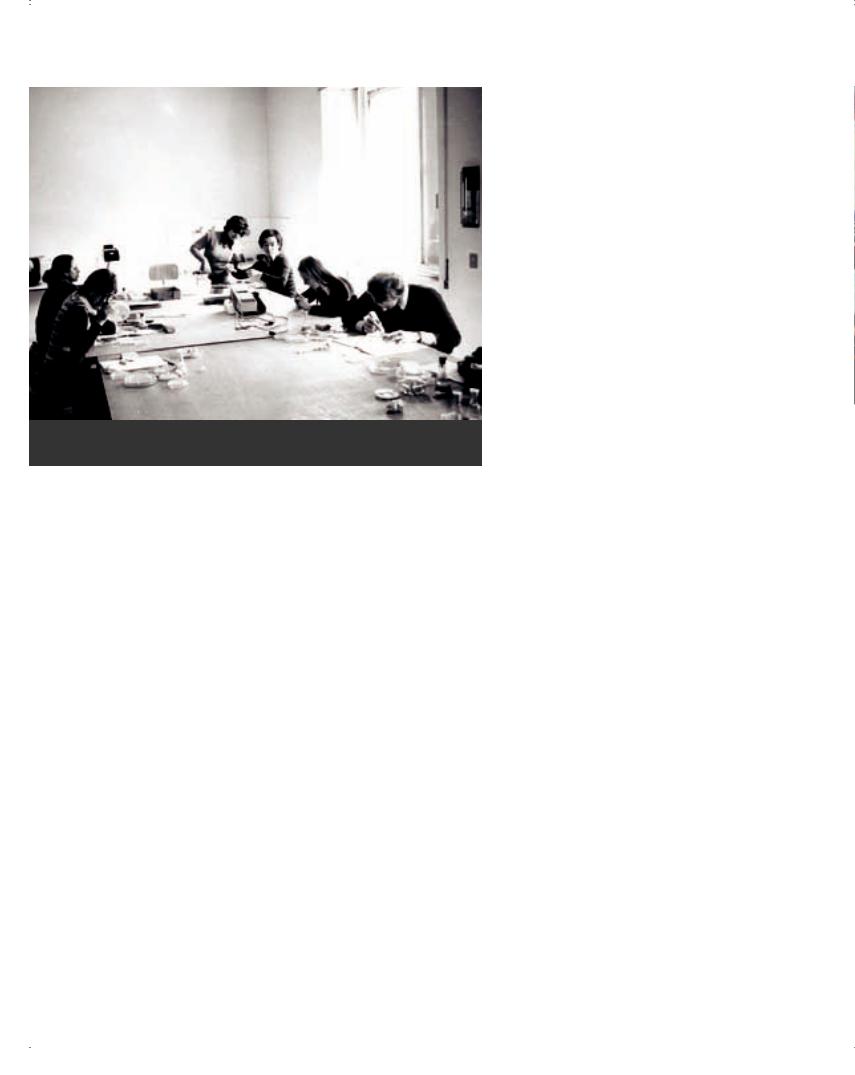
Figure 4 22
SPC 1976 participants doing course work
new course that Plenderleith had proposed to call the Fundamental Principles of Conservation (later changed to Scientific Principles of Conservation). Torraca has written about training:149
“Even if teaching could be provided by the supporting institutions or by individual international experts, the presence of a technical and scientific staff in the house was a positive factor for the courses. In first place, the home staff would teach free of charge (as would the Istituto del Restauro and Rome University staff). Second, the internal staff could improve the general quality of the courses by influencing the choice of the invited experts and assessing their performance.
One course (Scientific Principles of Conservation, or SPC) required a laboratory because it had been designed as a material science course in which, after an introduction about general science, weekly sessions would be devoted to single types of material (e.g. wood, metals, stone, paper and others). Each week, mornings would be devoted to lectures while the afternoons were to be given over to hands-on activity in the laboratory. The general idea behind the SPC course was that if conservators, architects, historians and scientists active in conservation
knew about the structure of materials and their durability problems they would be less likely to cause damage to the cultural property they dealt with in the future. Furthermore, by studying together, the various professions could slowly develop a common language and interact more efficiently in subsequent inter-disciplinary work.”
Philippot commented about this course in an interview (October 2001):
“We all agreed that a restorer needed training in science, physics, and so on. But when you mention this, you have not actually yet specified what subjects should be taught. It is here that one had to work, because it was necessary to identify in the whole field of science, if you should teach the basics, or if you should teach specific issues so that these could become useful for the restoration. The work of Giorgio consisted in the identification of precise areas of science, which could be more general, such as climatology, or rather more specialized, such as the theory of solvents, and to elaborate the information in a way that it could be understandable to anybody even without a scientific background. The scope of the Course of Conservation Science was to make the subject matter directly accessible to anybody who was involved in restoration. In this sense it was a revolution. It could be understood by an art historian and by a restorer, as well as being useful for a chemist at the same time. This course of Conservation Science has then had several offshoots. It could be adapted to different fields, taking into account one or the other subject, addressing the needs of an archivist or an archaeologist.”
The first course on the Fundamental Principles of Conservation took place (10 January to 5 April 1974) in experimental form with the participation as teachers of Albert France-Lanord, Bruno Mühlethaler, Marc Mamillan, Garry Thomson and Clelia Giacobini. There were nine participants from Egypt, Norway, Libya, Poland, Canada, Iran, Australia, USA and France. In the following year the course was further developed and attended by a multidisciplinary group of 13 restorers, chemists, archaeologists and conservators. In order to reduce the language communication problems in such a mixed group, the Centre prepared didactic slides and fiches on the subjects taught in the course, amounting eventually to ca. 2 500 cards in several languages.
58 |
ICCROM and the Conservation of Cultural Heritage. A history of the Organization’s first 50 years, 1959-2009 |
|
|
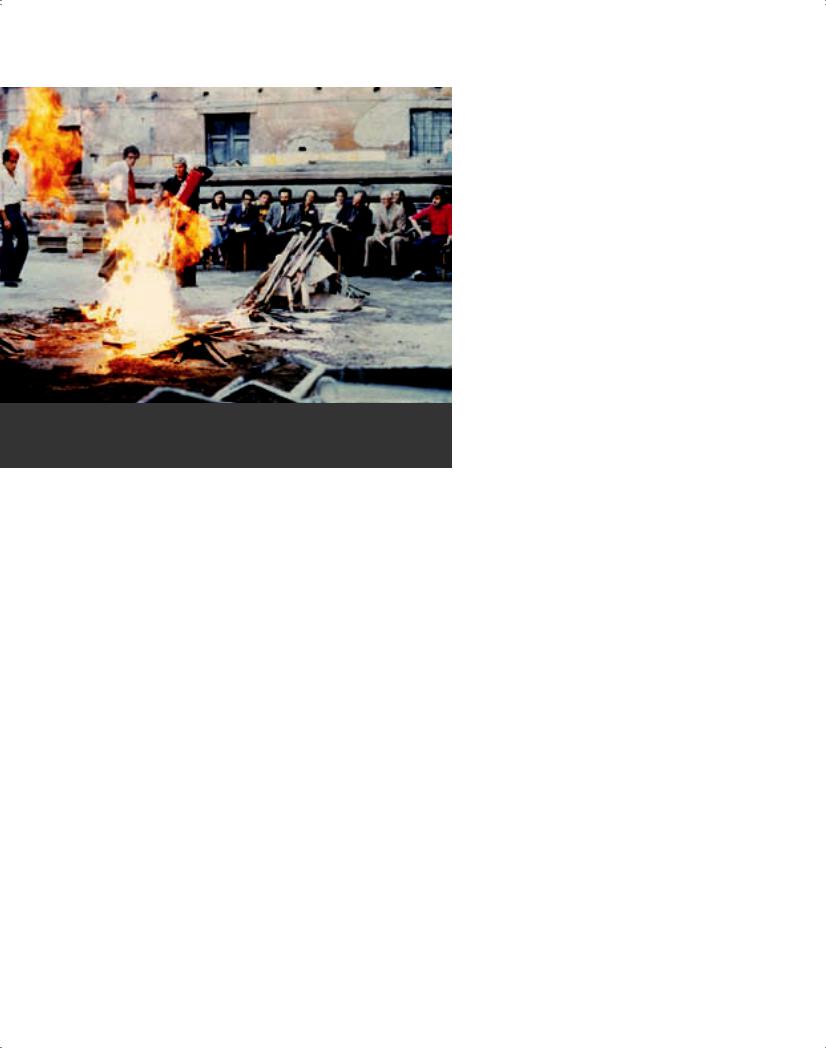
Figure 4 23
Security, Climate Control, and Lighting in Museums; demonstration of the use of fire extinguishers, guided by Gaël de Guichen
Security, climate control and lighting in museums
The Course on Security, Climate Control, and Lighting in Museums was conceived as a refresher course to meet the essential needs for the responsible conservation of museum collections. It was conceived and co-ordinated by Gaël de Guichen, with the assistance of Pia Pierre (France) and financed through a special subvention from the French Government. They developed the programme of the course in collaboration with specialists, and did original research to prepare the required didactic material. Some of the didactic material formed part of a semi-permanent exhibition on the ground-floor of the Centre which was designed by Gaël de Guichen and Christopher Wheatley (Laboratory technician, 1978-1982).
The first two-week course took place at the Centre from 24 September to 7 October 1975, attended by 18 participants from 10 countries. In 1976, there were 17 participants from 14 countries. The participants were mid-career museum curators with an average age of 42. This refresher course became part of the Centre’s regular annual programme in the month of September.
Stone conservation in Venice
As part of the international response to the floods that devastated the city of Venice in the 1960s and 1970s, UNESCO in collaboration with ICCROM decided
to establish an international training programme on stone conservation. The first course took place in the Abbazia della Misericordia in Venice under the auspices of UNESCO and in collaboration with the Italian authorities, including ICR (for eight weeks in October–November 1976, with 14 participants from 12 countries). It was repeated in 1978 and became a regular biennial course. The Venice in Peril Fund made available a work site in the Ducal Palace. Torraca coordinated the course with the assistance of Lorenzo Lazzarini and Giulia Musumeci-Hempel, taking advantage of the research in stone conservation being carried out within the framework of the UNESCO international campaign.
Training typology
With experience of the variety of activities that the International Centre for Conservation was undertaking, Philippot decided to propose a systematic analysis of the training needs for the different disciplines involved in the conservation of cultural properties. His list included: a) architects, engineers and town planners, b) historians, art historians and archaeologists, c) foremen on work sites, d) restorers and conservators, e) technicians in conservation, f) artisans, g) conservation scientists and laboratory technicians. He noted later150:
“I prepared a systematic framework for teaching subjects, which was then published in the Newsletter of ICCROM. It was necessary because the courses included many subjects, all mixed up. My intention was to try to clarify the situation, showing the different levels, from strictly technical to the more advanced addressing people who need to be able to make decisions. For me, this second group is the more critical one. A real restorer should be a person with the capacity to assume the responsibility for a worksite, capable of making a diagnosis, lead the team, manage the work, and take decisions. When the project is important, such as the case of the mural paintings of Assisi, one naturally needs qualified workers, who are well equipped technically, and who understand what they are doing, following the decisions of the leader. I believe that this division is still a valid one. Naturally, teaching should correspond to two different levels.”
The proposed typology was also a further attempt to stress the methodological unity of the
4 International Centre for Conservation (1971-1977) |
59 |
|
|
